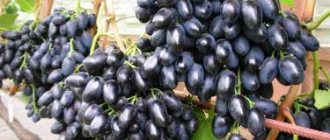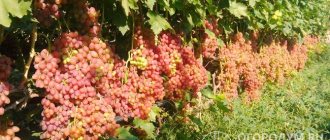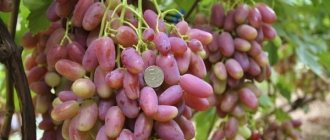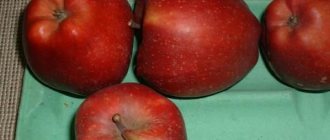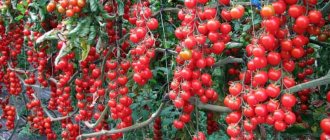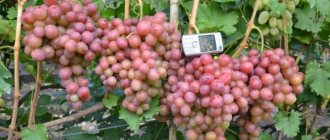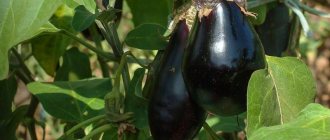Russia is a country with rather harsh climatic conditions in many regions. This indicator greatly complicates the development of viticulture on an industrial scale. However, the Amur Breakthrough grape may surprise you.
The capricious variety Vitis vinifera and its closest American relatives are not able to grow in the snowy and cold Russian winter. But despite this sad situation, Amur grapes grow in the Far East and Siberian taiga. He is not bothered by such trifles as diseases or fungi. And also severe frosts.
Due to the fact that wild berries are rarely used for eating uncooked, they are also not suitable for making some culinary masterpieces, the Amur Breakthrough grape variety was not particularly interesting for gardeners.
Popular hybrids
Amur grapes today are represented by a huge number of varieties. Below we will present you the most popular and well-proven varieties.
Marinovsky
Medium-sized clusters ripen in early September. The berries are small, slightly elongated. Thin skin dark blue. They have a subtle aroma and the taste is not very expressive.
Amethyst
Quite a powerful plant, which is characterized by bisexuality. Up to four clusters ripen on one shoot. The berries are fully ripened at the end of August. They are very juicy and sweet, the skin is dark blue. The clusters are large, the berries are medium in size, round. The fruits of this variety do not infect wasps. This variety produces the first harvest the next year after planting. It is resistant to most fungal diseases typical of grapes.
Triumph
The plant is quite powerful. The fruits ripen at the end of August. They are painted dark pink and are quite large in size. The variety has excellent taste. Productivity increases with plant age.
Agat Donskoy
Many winegrowers believe that this variety has the juiciest and most delicious berries. Excellent juices and wines are made from them. The plant is bisexual and highly resistant to common diseases.
Neretinsky
The variety has functional female flowers. Pollinators can be Amethyst, Agate, Marinovsky and other bisexual forms. Wine made from the berries of this variety has a chocolate flavor. The berries ripen at the end of August. It often bears fruit in the second year.
New Russian
Extra early table variety. The fruits ripen at the end of July. Powerful and bisexual variety. The berries are oval in shape with a red skin. It has a special spring taste. The pulp is juicy and fleshy.
Amur breakthrough
This is, without exaggeration, the most popular variety. It is for this reason that we will talk about it in more detail.
Comparison with analogues
Below is a table that clearly shows the pros and cons of the “Amur Breakthrough” variety in comparison with other early ripening technical varieties.
| Sign | Variety | |||
| Amur breakthrough | Zilga | Alpha | Rondo | |
| Ripening period | 110 days | 102 – 110 days | 110 – 145 days | 100 – 120 days |
| Frost resistance | -40C | -32C | -35C | -24С |
| Productivity | Up to 100 kg | 300 – 400 c/ha | 150 – 180 c/ha | Up to 150 c/ha |
| Bunches | 200 – 400 g | 200 – 400 g | 150 – 250 g | 120 – 200 g |
| Taste | Simple, harmonious | Isabelle taste and aroma | Isabelle flavor | Simple, harmonious |
| Color | Dark blue | Blue | Violet | Dark blue |
| Disease resistance | High | Average | Above average | Above average |
| Shelf life | Up to 1 month | 3 – 4 months | Up to 2 months | 1 – 3 months |
| Sugar accumulation | 23% | 18 – 20% | 15 – 16% | 19 – 21% |
| Acidity | 6 – 7 g/l | 4 – 7 g/l | 10 – 11 g/l | 9 – 10 g/l |
Amur breakthrough grapes: variety description, reviews
This variety has two more copyright names - Odin and Potapenko-7. According to experienced winegrowers, the variety is distinguished by its unpretentiousness, endurance and ease of care.
It was developed by A.I. Potapenko based on Amur natural forms. The Amur breakthrough grape is distinguished by its powerful growth force and unusual foliage, which acquires an elegant crimson color in the fall. Thanks to these decorative properties, according to winegrowers, the variety can be successfully used in landscape design.
History of the variety
Amur breakthrough is a cultivated type of wild Amur grape that grows naturally in the Far East and northern China. It was bred by breeder A.P. Potapenko. In terms of cold resistance (withstands frosts of -35...-40 °C) and unpretentiousness, it is not inferior to its wild ancestor, but other valuable characteristics have been improved.
A universal-purpose grape with large, dense clusters, it is classified as a table variety. It has been in the State Register of the Russian Federation since 2018, suitable for cultivation in all Russian regions.
Leaves
The Amur breakthrough grape, a description of which today can be found in almost all reference books on gardening and viticulture, produces fairly large leaves of a light green color. They have a round or elongated shape, with small sharp teeth along the edges.
The inner side of the leaf plate is covered with soft down. In autumn, the foliage turns purple-red, which is why the variety is often used to decorate fences and gazebos. Leaf fall begins in early October.
Berries
The Amur breakthrough grape variety is famous for its excellent taste, although many believe that northern varieties must be sour and small, suitable only for making compotes.
The berries are round in shape with dark purple or dark pink dense skin that literally glows in the sun, about one and a half centimeters in diameter and weighing up to four grams. The fruits of this grape are characterized by a high sugar content (23%). This figure is considered high even for many southern table varieties.
The weight of the bunches largely depends on the cultivation conditions. The average weight of a bunch is 400 grams, but some winegrowers manage to grow kilogram bunches. From one bush, 10 kg or more of berries are harvested. The fruits have a pleasant, refined taste and can be used for consumption both fresh and for use in making wine, preserves, compotes and jams. A coffee substitute is made from the seeds and aromatic oil is obtained.
Frost resistance
Without exaggeration, we can say that the Amur Breakthrough grape is a champion in winter hardiness. Amazingly, adult bushes are able to winter without shelter and tolerate frosts down to -40°C. However, it is better to protect young vines from severe frosts. It is better to remove the grapevines from the trellises for the winter so that they are covered with snow.
Very low temperatures can destroy a third of the vine, but the plant instantly recovers and bears fruit beautifully. It is these qualities that made the Amur Breakthrough grape so popular. Buying seedlings in Moscow is not difficult. You can increasingly see these grapes in areas near Moscow.
Formation of grape bushes
Scheme of grapevine formation:
- In the 1st year, 2 strong shoots are left.
- In the 2nd year, 2-3 buds are left on each, and the top is cut off.
- On the 3rd of them, 2 large shoots are selected and shortened to 0.5 m. During the summer, 2-3 shoots grow on each.
- On the 4th, the top branch will bear fruit; it is pruned into 10-15 buds. The lower branch is a replacement shoot, consisting of 3 buds.
In the following seasons, the pruning pattern is repeated, the shoot that will produce berries in the current season is formed from 15 buds, and the replacement shoot is formed from 3 buds. There should be enough 1-year-old shoots left on the bush so that the total number of fruiting buds is 6-10 dozen.
Amur grape bushes are grown on a trellis, in a horizontal position. The main branches occupy 2 lower tiers of wire, young ones are tied vertically to the upper ones. Green excess vines are pruned in the summer, without waiting for autumn. The bushes do not need shelter for the winter.
The new cold-resistant variety Amursky Breakthrough is intended primarily for cold regions of Russia and is considered promising for cultivation in climatic conditions unfavorable for the crop. The variety is productive and is considered a table variety, but the berries can also be used for processing, including for the production of red juice, the yield of which is at the level of 70-75% of the weight of the berries.
Features of cultivation
The unpretentious and hardy Amur Breakthrough grape requires compliance with the simplest rules when planting and caring. You can grow it in the following ways:
- seeds;
- layering;
- cuttings.
The seeds remain viable for five years. The average germination rate is 60%. However, in this case there is a risk of loss of varietal qualities. A vine grown from seeds bears fruit late, after almost five years.
Seeds are planted in the fall to a depth of one and a half centimeters. They are soaked before planting. In the spring, they can be planted in pots and grown indoors until they germinate and become seedlings.
However, most gardeners prefer to plant Amur breakthrough grape seedlings in the summer. The bottom of the planting hole, fifty centimeters deep, is covered with a ten-centimeter layer of crushed stone, then soil, fertilizers and top nutrient layer of soil are poured.
Amur breakthrough grapes are undemanding to soil quality. The description of the variety given by A.I. Potapenko, at the same time, emphasizes the fact that the variety grows and bears fruit best on acidic, well-moistened soil. If the soil on your site is alkaline, then it can be acidified by adding turf soil or peat. After planting, seedlings are watered abundantly.
Medicinal properties
We hope that you have learned a lot of interesting things about Amur grapes (planting, care). The medicinal properties of this plant also cannot be ignored. Amur grapes are a unique plant, one of the survivors of the Ice Age. He adapted to the harshest conditions. This grape produces more than one hundred and fifty active substances.
The berries contain many B vitamins and pectins, fiber and essential oil, hemicellulose and protein, folic and organic acids, sucrose and antioxidants. A unique substance was found in the leaves and skin - resveratrol. It is called the “elixir of youth” for its special ability to slow down the aging process. This is a very powerful antioxidant that has been proven effective in scientific experiments.
A medicinal tincture is made from Amur grapes, which helps fight many diseases:
- diseases of the heart and blood vessels;
- diabetes;
- benign tumors;
- immunodeficiency;
- some liver pathologies;
- varicose veins;
- angina pectoris;
- atherosclerosis;
- hypertension.
To prepare this tincture, petioles, berries or leaves of the plant are used. If you use berries, you need to squeeze them out and leave only the dry cake - in this case you won’t need juice. It must be filled with 500 ml of vodka and left for a week in a cool and always dark place. The tincture is consumed in the morning, adding a teaspoon to one hundred grams of tea.
A decoction is first made from the leaves and petioles. One hundred grams of raw material is poured into 500 ml of water and brought to a boil. Add 100 ml of vodka to the hot broth and cool the mixture. The product is ready for use as soon as it cools down. The dose is the same as in the first recipe. For healthy people, this tincture is suitable as a preventive measure. It will improve memory, give strength, and improve the condition of hair and skin.
Amur breakthrough grapes: reviews from gardeners
This variety can be grown not only in the northern regions, but also in the middle zone. Although some winegrowers from the Moscow region note that it is quite difficult for it to take root, the powerful bushes then delight with rich harvests of healthy and very tasty berries.
This variety has received conflicting reviews regarding disease resistance. In most reference books, the variety is called complexly resistant, but at the same time, winegrowers in the middle zone note that the plant is often affected by mildew. Many believe that the Amur breakthrough best shows its qualities in Primorye, where weather conditions are somewhat smoother: there are no spring frosts characteristic of the middle zone.
Gardeners include the following undeniable advantages of the variety:
- abundant fruiting;
- genetically inherent high plasticity;
- high frost resistance;
- the ability of the vine to withstand high loads;
- early growing season;
- excellent taste characteristics of berries;
- the most valuable medicinal properties inherited from the parent varieties.
Reviews
It tastes sour, but the wine is very tasty. Alexander, Moscow region
The berries are black, quite large, large clusters (600 - 700g, sometimes up to 1 kg.) Sugar content 23%. Ripening period: end of August – mid-September. Withstands frosts down to –41°C. It is practically not affected by diseases. Yuri, Saratov
It bears fruit for the third year. Bunches no more than 200g. The taste is good - winey. Obviously frost-resistant, excellent resistance to diseases. The vine is clean and ripens completely. Vigorous. Victor, Sumy

